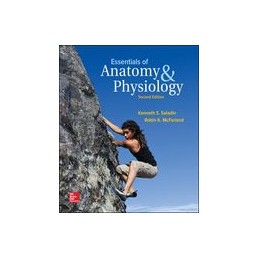- Reduced price

Order to parcel locker

easy pay


 Delivery policy
Delivery policy
Choose Paczkomat Inpost, Orlen Paczka, DHL, DPD or Poczta Polska. Click for more details
 Security policy
Security policy
Pay with a quick bank transfer, payment card or cash on delivery. Click for more details
 Return policy
Return policy
If you are a consumer, you can return the goods within 14 days. Click for more details
Data sheet
1.1 Anatomy—The Structural Basis of Human Function
1.2 Physiology—The Functional Relevance of Human Structure
1.3 The Human Body Plan
1.4 The Language of Medicine
2.1 Atoms, Ions, and Molecules
2.2 Water, Mixtures, and pH
2.3 Organic Compounds
2.4 Energy and Chemical Reactions
3.1 The General Structure of Cells
3.2 The Cell Surface
3.3 The Cell Interior
3.4 The Life Cycle of Cells
4.1 The Study of Tissues
4.2 Epithelial Tissue
4.3 Connective Tissue
4.4 Nervous and Muscular Tissues—The Excitable Tissues
4.5 Glands and Membranes
4.6 Tissue Growth, Development, Repair, and Death
5.1 The Skin and Subcutaneous Tissue
5.2 Accessory Organs
6.1 Skeletal Structure and Function
6.2 Bone Development and Metabolism
6.3 The Axial Skeleton
6.4 The Appendicular Skeleton
6.5 Joints
7.1 Muscular Tissues and Cells
7.2 Physiology of Skeletal Muscle
7.3 Cardiac and Smooth Muscle
7.4 Anatomy of the Muscular System
8.1 Cells and Tissues of the Nervous System
8.2 The Physiology of Neurons
8.3 The Spinal Cord, Spinal Nerves, and Reflexes
9.1Overview of the Brain
9.2Principal Divisions of the Brain
9.3Multiregional Brain Functions
9.4The Cranial Nerves
9.5The Autonomic Nervous System
10.1Receptors and Sensations
10.2The General Senses
10.3The Chemical Senses—Taste and Smell
10.4The Ear—Hearing and Equilibrium
10.5The Eye and Vision
11.1Overview of the Endocrine System
11.2Endocrine Physiology
11.3The Hypothalamus and Pituitary Gland
11.4Other Endocrine Glands and Tissues
11.5Stress Physiology
12.1Introduction
12.2Erythrocytes
12.3Leukocytes
12.4Platelets
13.1Overview of the Cardiovascular System
13.2Gross Anatomy of the Heart
13.3Physiology of the Heart
13.4General Anatomy of Blood Vessels
13.5Physiology of Circulation
13.6Circulatory Routes and Blood Vessels
14.1The Lymphatic System
14.2Nonspecific Resistance
14.3Features of Adaptive Immunity
14.4Cellular and Humoral Immunity
15.1Functions and Anatomy of the Respiratory System
15.2Pulmonary Ventilation
15.3Gas Exchange and Transport
16.1Functions of the Urinary System
16.2Anatomy of the Kidney
16.3Glomerular Filtration
16.4Tubular Resorption and Secretion
16.5Water Conservation
16.6Urine Storage and Elimination
16.7Fluid, Electrolyte, and Acid–Base Balance
17.1Overview of the Digestive System
17.2The Mouth through Esophagus
17.3The Stomach
17.4The Liver, Gallbladder, and Pancreas
17.5The Small Intestine
17.6Chemical Digestion and Absorption
17.7The Large Intestine
18.1Nutrition
18.2Carbohydrate Metabolism
18.3Lipid and Protein Metabolism
18.4Metabolic States and Metabolic Rate
18.5Energy Balance and Appetite Regulation
18.6Body Heat and Thermoregulation
19.1Essentials of Sexual Reproduction
19.2The Male Reproductive System
19.3The Female Reproductive System
19.4The Production and Union of Sex Cells
19.5Pregnancy, Childbirth, and Lactation
20.1Fertilization and Preembryonic Development
20.2The Embryonic and Fetal Stages
20.3The Neonate
20.4Aging, Senescence, and Death
Reference: 71158
Author: Christine E. Kasper
Reference: 39262
Author: Shauna C. Anderson
Reference: 33057
Author: Abraham L Kierszenbaum
With STUDENT CONSULT Online Access
Reference: 68196
Author: Jean W. Lange
Reference: 103086
Author: Deepak Prabhakar
